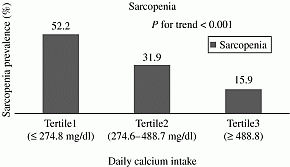ICEECE2012 Poster Presentations Calcium & Vitamin D metabolism (73 abstracts)
The daily calcium intake is associated with sarcopenia in older, non-obese koreans: the fourth korea national health an nutrition examination surveys (KNHANES IV) 2009
C. Park, E. Rhee, K. Oh, S. Park, S. Park, S. Kim, W. Lee & M. Seo
Kangbuk Samsung Hospital, Seoul, Republic of Korea.
Backgroud: The association with daily calcium intake and sarcopenia has not been well established.
Objective: The objective was to assess the associate of daily calcium intake and sarcopenia.
Methods: We analysed the fourth Korea National Health and Nutrition Examination Survey (KNHANES) in old adult (over 50 years), conducted in 2009. A total of 1964 non-obese (body mass index (BMI) <25 kg/m2) old adults (871 men and 1093 women) were enrolled. Dietary variables were assessed using a 24 h recall method in the nutrition survey. The intake of daily calcium from the consumption of each food item was calculated. Sarcopenia was defined as an appendicular skeletal muscle mass divided by body weight that was less than two S.D. below the sex-specific mean for young adults. Obesity was defined as a body mass index (BMI) of 25 kg/m2 or higher.
Results: Daily calcium intake correlated negatively with appendicular fat mass, although not significant (P=0.201). However, we found that Daily calcium intake correlated positively with appendicular skeletal mass (P<0.001). Our study showed that participants with sarcopenia have significantly lower daily calcium intake compared to participants without sarcopenia (P<0.001). The unadjusted prevalence of sarcopenia according to tertiles of daily calcium intake were 52.2, 31.9 and 15.9% in tertile1 – tertile 3. After adjustment for age, sex, BMI, total energy intake and lifestyle factors, compared with those in the lowest tertile of daily calcium intake, participants in the highest tertile had an odds ratio for sarcopenia of 0.311 (95% CI, 0.129–0.748).
Conclusion: Our study suggest that there is a strong inverse association between daily calcium intake and sarcopenia in non-obese old adult Korean.
Adjusted Odds ratiom and 95% CI of sarcopenia by tertiles of daily calcium intake.
| Tertile of daily calcium intake (mg/d) | T1(<274.8) n=654 | T2(274.6–488.7) n=656 | T3(>488.8) n=654 | P for trend |
| Unadjusted | 1(ref) | 0.596 (0.346–1.024) | 0.294 (0.148–0.582) | <0.001 |
| Model 1 (age and sex) | 1(ref) | 0.677 (0.387–1.185) | 0.352 (0.173–0.719) | 0.003 |
| Model 2 (age, sex, BMI and total energy intake) | 1(ref) | 0.712 (0.392–1.293) | 0.421 (0.192–0.921) | 0.029 |
| Model 3(age, sex, BMI, total energy intake and serum vitamine D) | 1(ref) | 0.549 (0.291–1.033) | 0.345 (0.152–0.783) | 0.008 |
| Model 4 (age, sex, BMI, total energy intake, HOMA-IR, regular exercise, occupation, region, smoking, alcohol drinking, and vitamin, mineral supplement use) | 1(ref) | 0.596 (0.309–1.149) | 0.317 (0.133–0.756) | 0.008 |
| Model 5 (age, sex, BMI, total energy intake, serum vitamine D HOMA-IR, regular exercise,occupation, region, smoking, alcohol drinking, and vitamin, mineral supplement use) | 1(ref) | 0.590 (0.303–1.148) | 0.309 (0.129–0.742) | 0.007 |
| Model 6 (age, sex, BMI, total energy intake, serum vitamine D, PTH HOMA-IR, regular exercise, occupation, region, smoking, alcohol drinking, and vitamin, mineral supplement use) | 1(ref) | 0.589 (0.303–1.147) | 0.311 (0.129–0.748) | 0.007 |

Figure 1. Unadjusted prevalence of sarcopenia by tertiles of daily oral calcium intake
Declaration of interest: The authors declare that there is no conflict of interest that could be perceived as prejudicing the impartiality of the research project.
Funding: This research did not receive any specific grant from any funding agency in the public, commercial or not-for-profit sector.




